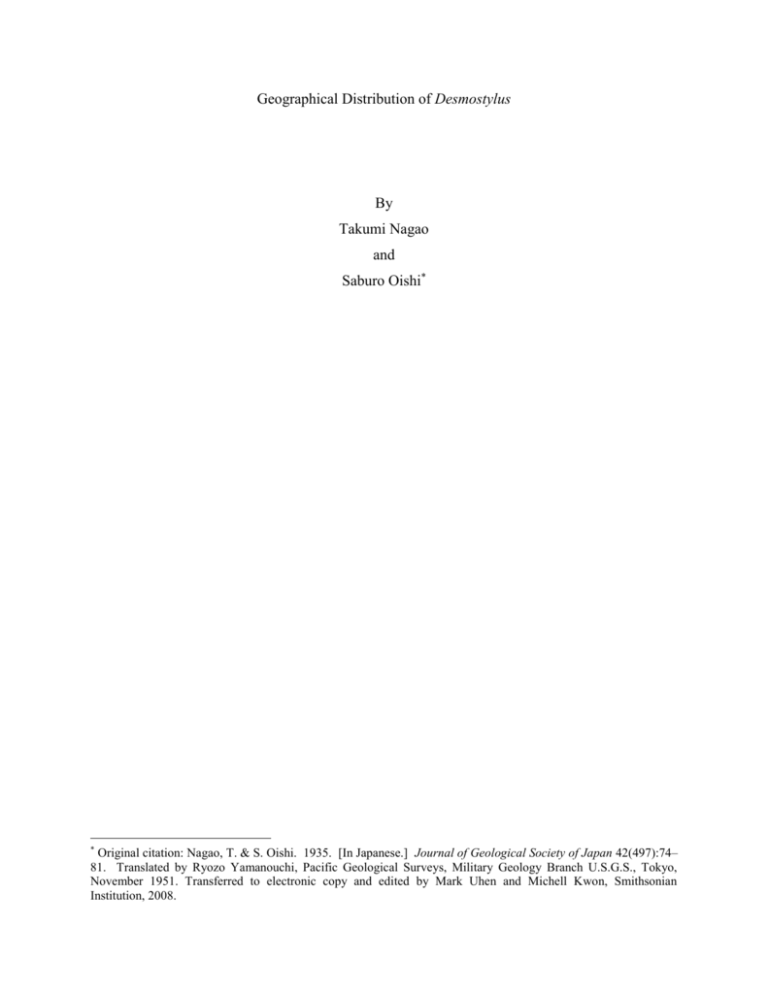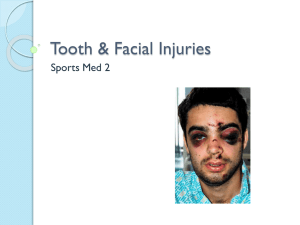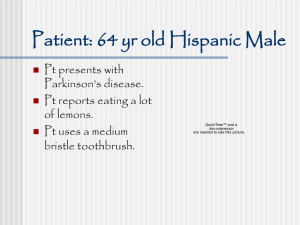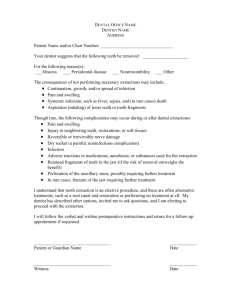Geographical Distribution of Desmostylus
advertisement

Geographical Distribution of Desmostylus By Takumi Nagao and Saburo Oishi* * Original citation: Nagao, T. & S. Oishi. 1935. [In Japanese.] Journal of Geological Society of Japan 42(497):74– 81. Translated by Ryozo Yamanouchi, Pacific Geological Surveys, Military Geology Branch U.S.G.S., Tokyo, November 1951. Transferred to electronic copy and edited by Mark Uhen and Michell Kwon, Smithsonian Institution, 2008. A number of skull fragments of Desmostylus have been found in North America and in Japan since the genus was first discovered in 1888 California by Marsh1. In 1902 a skull was reported from Mino Province by Dr. Tokunaga and Dr. Iwasaki 2, and later in 1907 another skull3 was found. The latter was devoid of the snout of the upper jaw and the lower jaw but could supplement the missing part of the one from Mino Province. When these two were put together, it was possible to tell approximately the arrangement of the teeth and the appearance of the head. However, there are still widely varied opinions regarding the classification of Desmostylus. Marsh classified it as Sirenia, and many scientists have since tried to demonstrate its relationship to Sirenia. Some scientists advocated that it is affiliated with the Proboscidea, and recently Abel4 insisted that it is especially closely related to the Monotremata. It is certain that many properties of the skull lead us to think it is related to Sirenia, yet the peculiar shape of its teeth and its composition have puzzled scientists for a long time. Some scientists, Abel for one, consider it nothing but casual results or adaptive features resulting from its marine habitat, and therefore, the similarity to Sirenia. What has given rise to such long prolonged and various controversies may be chiefly ascribed to the absence of explicit forefathers or descendants of the animal. Another reason may be the imperfect preservation of fossil specimens as objects of research. Although most Sirenia, both living and fossil, have hind limbs degenerated to fit marine life, it was a problem to decide whether it was the case with Desmostylus. The writers, as reported in the Geographical Magazine5, obtained the third skull last summer, and was told then that the probable bones of the animal existed in the locality at Keton, Shikuka Machi, Shikuka Gun, Karafuto. Thanks to subsidies granted by the Science Promotion Council, the writers could gather the greater part of the left forelimb in the fall of last year. In the summer of this year we were able to gather the ribs, most of the backbones, the pelvis and the hind limbs, i.e., the writers succeeded in 1 O.C. Marsh, Notice of a new fossil Sirenian, from California, Amer. Jour. Sci., Ser. 3, Vol. XXXV, p. 94, 1888. S. Yoshiwara and J. Iwasaki, Notes on a new fossil Mammal, Jour. Sci. Fac. Imp. Univ., Tokyo. Vol. XVI, Art. 6, 1902. 3 O.P. Hay, A contribution to the knowledge of the extinct Sirenian Desmostylus hesperus Marsh, Proc. U.S. National Mus., Vol. XLIX, pp. 381-397, 1915. 4 O. Abel, Desmostylus, Ein mariner Multituberculata aus dem Miozan der nordpazifischen Kustenregion. Acta Zoologica, Vol. III, 1922, pp. 361-394, Lehrbuch der Palaozoolgie, 1924, pp. 431-434. 5 Takumi NAGAO & Saburo OISHI, On the remains of Desmostylus discovered in the vicinity of the border of Karafuto, Geographical Magazine, 46th year, pp. 103-111, 1934. 2 collecting most of the bones of Desmostylus. And they express their sincere gratitude to the people of the above-mentioned organization. As aforementioned, the bones were found in marl nodules. The encircling rocks and stones were extremely hard because of calcium secreted from the bones. This not only made excavation very difficult, but also made the indoor work of taking out individual bones time consuming. As the latter work is still going on the details of the rock will be given later. In the previous report the writers reported the geology and embedded state of the bones; in this report they will describe the district producing the fossils up to now, in other words, the geographical distribution and the specimens at each locality. As for the teeth pattern, geological distribution, ecology, and the difference between the known ones, they will be reported in the future. I. The Japanese Localities and the Specimens In Japan, the localities extend from Karafuto in the north southwards to Mino and Izumo Provinces. The known localities and their specimens will be mentioned hereunder; there may be some others which have not been reported yet. 1. The earliest discovery in record was in 1897 when one molar was obtained by Mr. Ito at Yu no Machi, Izumo Province. This, together with the teeth discovered by Dr. Tokunaga and Dr. Iwasaki6 in Mino in 1902, were composed into a picture. These were all composed of five columnar bodies. A tooth of Desmostylus is by nature made up of four or eight columnar bodies in its crown, each being nearly cylindrical. However, if each is closely connected together the cross section is polygonal. When a tooth is un-used and not worn out, the margin of the upper surface is concave and the inner fringe is a little hollow. In the central part, the surface looks like a slightly projecting breast. As it gets worn out, the upper surface becomes flat and the external part composed of thick enamel and the central part composed of dentine appears. When a tooth has a neighboring one in front or in rear, it gets polished in the front or rear contact surface respectively; on the other hand, if a tooth is found to have a round upper surface without wearing out, it can be considered to have been still in the socket. The teeth from Yu no Machi, Izumo Province, which is composed of five columnar bodies, is considerably worn out on the masticating surface. It was at first regarded as a (major) molar on the lower jaw by Dr. Tokunaga 6 S. Yoshiwara & J. Iwasaki, The aforementioned footnote 2, p. 9, p1. 3, fig. 7. and Dr. Iwasaki, but later Dr. Matsumoto7 considered it the first molar M1 on the upper jaw; the latter may probably be correct. 2. The fossil discovered at Togari, Toki Gun, Gifu Ken, about 1898, is the famous skull that was described by Dr. Tokunaga and Dr. Iwasaki2. This is the type specimen of Desmostylus japonicus. As is known widely, this bone is devoid of the cranium and the back part of the lower jaw; but otherwise the bone is nearly perfect. It has six incisors and seven molars and a molar in the socket. These are now in the possession of the Tokyo Science Museum. 3. Another tooth is said to have been discovered in Mino by Dr. Tokunaga2, but no detailed report has been made yet. 4. A third fossil from Tsukiyoshi, Yamanouchi, in the same district, was reported in the description of Dr. Matsumoto8, but no report is made about what part it is. 5. It is reported that fossils have been discovered from the Tertiary System in the Fukuoka District, Iwate Ken, and that a number of teeth have also been found at Yuda and Shikonai of the same prefecture, but no report has been made yet9. 6. According to Dr. Tokunaga and Dr. Iwasaki10, a tooth was discovered in a manganese mine along the Ribetsu Gawa, Shiribetsu Gawa, Shiribeshi no Kuni, a long time ago. (To the best of the writer’s knowledge, it seems to have been discovered in the vicinity of Meppu, Ribetsu Mura, Setana Gun, in the drainage of the Ribetsu Gawa.) 7. The beds in the vicinity of the Meppu Mine are developed south-westwards across the river. A very imperfect part of a tooth (only two columnar bodies) was also discovered last year in a manganese mine to the south of Seoi Goe (pass), south of Setana. This is now in the possession of Geological and Mineralogical Institute of the Hokkaido University11. 8. Although the locality is not made clear, the writers have agreed that the tooth that was discovered in the drainage of the Oberashibe Gawa and was described by Dr. Matsumoto 12 as Desmostylus cf. japonicus, was the second molar (M2) of the upper jaw. The tooth was an unused one as the doctor said. 7 H. Matsumoto, A contribution to the morphology, paleobiology and systematic of Desmostylus. Bull. Sci. Fac. Imp. Univ. Tohoku, Ser. II, Vol. III, p. 63, 1918. 8 Hikoshichiro, Matsumoto, The table of fossil mammal deposits in Japan, Geol. Mag., Vol. XXIII, p. 293, 1916. 9 Ibid. 10 S. Yoshiwara & J. Iwasaki, Notes on Desmostylus japonicus, Geol. Mag., Vol. XXI, 1914. 11 Takumi Nagao & Yasuo Sasa, The Neozoic system in the southwest of Hokkaido and the recent geological history, Geol. Mag., Vol. XL, p. 756, 1933. 12 H. Matsumoto, The aforementioned footnote 7. 9. The two teeth gathered between Aikawa and Sawabe, Sado Is. In 1924 by Mr. Hiroshi Tabata has not been reported except the number of teeth13. 10. In 1928, a Mr. Sanji Furuuchi discovered a tooth from Aushi14 near Kishinoda on the west coast of Karafuto. The photograph taken by Mr. Fumio Saito shows that it is composed of seven columnar bodies and it is regarded as M2 of the lower jaw. Details will be given later. This specimen is preserved in the Toyohara Museum, Karafuto. Once Mr. Shiro Saeki, B.S., observing two pillars, described it as Desmostylus cf. japonicus; but in the writers’ opinion, it should be defined as the same as that from Keton. 11. Though the details have not been reported, it is said that Dr. Teiichi Tokuda discovered some teeth from the beds in the vicinity of Uchikawa, Shikuka Gun, on the east coast of Karafuto, several years ago15. 12. A recent discovery was made at Hatsuyuki Zawa back of Keton, Shikuka Machi, Shikuka Gun, as mentioned before; it has the skull (without the snout) as well as most bones. As the skull has the cranium, it can supplement the missing part of the skull from Mino, and furthermore, it has almost all the molars. The above-mentioned specimens from Japan proper have, it seems, some fragments of backbones and ribs16. No minute description, however, is available. 13. In addition, some fossils have been reported from North Karafuto by Khomenko17. In his report, a description is given about an imperfect shoulder blade18; this is the only description of the part other than the skull and teeth. II. The Localities on the West Coast of North America and the Specimens. The localities extend over from Alaska south to South California in the North American continent. The following is as much as the writers know. 13 Gimei Ozawa, A new locality of Desmostylus, Geol. Mag., Vol. XXXI, p. 317, 1924. Fumio Saito, The engineering geology in the vicinity of Aushi along the Nohisa Line, Geogr. Mag., 41st Year, p. 364, 1929. Shiro Saeki, The tooth of the Tertiary sea cows (Sirenia) discovered in Karafuto, Geol. Mag., Vol. XXXV, p. 569, 1928. 15 M. Yokoyama, Tertiary mollusca from South Karafuto, Jour. Sci. Fac. Imp. Univ. Tokyo, Ser. II, Vol. II, Part 10, p. 410, 1930. 16 H. Matsumoto, The aforementioned footnote 7, p. 61. 17 J.P. Khomenko, Desmostylus sp. des depots tertiaries de l’ite de Sakhalin. Bull. Com. Geol., XLVI, No. 3, p. 21, 1927. 18 J.P. Khomenko, Neue Ergebnisse uber die Familie der Desmostylus. Zapiski rossiiskovo mineralogicheskovo Obchestra, LVII, 1, p. 140, 1928. 14 1. The one that is the genotype and the type specimens of Desmostylus hesperus was reported by Marsh19 in 1888. At that time this was described as produced together with land mammals of the Pliocene of Alameda County, California; but according to the later description by Merriam20, it seems to be Contra Costa County. Although the material Merriam had obtained is not made clear, it is supposed to have contained several teeth and backbones. The picture he drew is that of three columnar bodies of a single tooth, which is considered part of the second molar of the upper jaw as Dr. Matsumoto has said. There is also a description stating that the best specimen among them is that of the lumbar vertebra. 2. In the description by Osborn21 in 1902 there is a quotation from Merriam which cites the following four as the localities: The first is a tooth discovered at Canores Canyon in the San Joaquin Valley in California. 3. The second is a tooth from San Jose in California. 4. The third one is in the possession of the California Academy of Science, of which the tooth locality is not known. (This was later drawn in a picture by Merriam22. He defined it as the first molar of the lower jaw.) 5. The fourth is from Yaquina Bay, Oregon. What seems to be this specimen was shown in detail in a picture by Hay23. (This is considered to be the second molar M2 of the upper jaw). 6. In 1906, Merriam24, added two new instances; one is from La Panza, San Luis Obispo County, California, which is composed of two columnar bodies of a tooth. 7. The other is from Santa Ana, Orange County of the same state and is composed of many “tooth fragments”. Merriam showed the fragments of molars in pictures25. 8. Later in 1911, Merriam26 further cited several places as the localities of the west side of the San Joaquin Valley; the first is the one discovered by F.M. Anderson to the north of Caolinga and is composed of lots of teeth fragments. 19 O.C. Marsh, The aforementioned note 1. J.C. Merriam, Notes on the Genus Desmostylus of Marsh. Univ. California, Publ. Bull. Dept. Geology, Vol. VI, p. 404, 1911. 21 H.F. Osborn, A remarkable new mammal from Japan. Its relationship to the Californian Genus Desmostylus, Marsh. Sci., NS., Vol. XVI, p. 713, 1902. 22 J.C. Merriam, The aforementioned footnote 20, p. 407, Figs, 2a, 2b. 23 O.P. Hay, A contribution to the knowledge of the extinct Sirenian Desmostylus hesperus Marsh. Proc. U.S. Nat. Mus., Vol. XLIX, p. 395, p1. 58, Figs. 3 & 4, 1915. 24 J.C. Merriam, On the occurrence of Desmostylus, Marsh, Sci. NS., Vol. XXIV, p. 151, 1906. 25 J.C. Merriam, aforementioned footnote 20, p. 408, Figs, 3. 26 J.C. Merriam, aforementioned footnote 20. 20 9. A second is from the Devil’s Den District to the south; this was also discovered by F. M. Anderson. 10. He also found a third locality in the Kern District on the east coast. 11. Still later, to the north of Coalinga, R. Anderson and R.W. Pakc found various parts, that contained a molar and tusk; the former, which he considered M1, was pictured in his report27. This was because a Japanese specimen of a tooth of the upper jaw composed of eight columnar bodies had been defined as M1. On the other hand, Hay28 classified this as a molar of the lower jaw; but the truth is, it should be defined as M2 of the upper jaw. 12. The most important discovery of Desmostylus is the skull from Spencer Creek, which flows into Yaquina Bay, Oregon. This is now in the possession of the National Museum in Washington, D.C. Although this specimen is devoid of the snout of the upper jaw and the whole lower jaw, this is only the second skull in the world. This was discovered by Crawford in 1907, which was 9 years later than the discovery of the one from Mino. In this specimen a considerable number of teeth of the upper jaw are retained; and though the columnar bodies have mostly been damaged, they can be counted. Of them, the writers will make a description some day. This discovery together with the specimen from Mino, has made a great contribution to the scientific world. This skull is considered to be that of Desmostylus hesperus. Hay29 gave a full description of this; later, Abel30 also described it. 13. In addition Hay showed the picture of a tooth31 which is considered to have belonged to another animal; this specimen is composed of four columnar bodies and is considered to be the last premolar P4 of the upper jaw. 14. Last of all, Hay showed a tooth from Alaska in his report of 192432. This tooth is composed of eight columnar bodies and is an unused tooth the position of which he could not define, but which he considered a molar of the left upper jaw. It may possibly be the second molar M2 of the upper jaw. 27 J.C. Merriam, aforementioned footnote 20, p. 407, Figs, 1a, 1b. O.P. Hay, aforementioned footnote 23, p. 395. 29 O.P. Hay, aforementioned footnote 23. 30 O. Abel, aforementioned footnote 4. 31 O.P. Hay, aforementioned footnote 20, p. 392, p1. 58, Figs, 5 & 6. 32 O.P. Hay, Notes on the osteology and dentition of the genera Desmostylus and Cornwallius. Proc. U.S. Nat. Mus., Vol. LXV, p. 1, p1 I, Figs, 1 & 2, 1924. 28 The above-mentioned ones are all defined as Desmostylus. Besides these, we also have Cornwallius sookensis (Cornwall). Two instances of them have been known up to now.33 1. The first is from the Coal Creek on Vancouver Island discovered by Egerton in 1916. At first it was determined by some scientists to be the same as Desmostylus hesperus. This tooth is a small molar which Lambe temporarily classified as the first molar M1 of the upper jaw; it is composed of six columnar bodies. 2. The second specimen was gathered by Cornwall and Cornell on the same island; this specimen is a big molar composed of six columnar bodies and is bigger than the former. The above two teeth were distinguished from hesperus and were named D. sookensis by Cornwall. Hay34, however, considered it a type and established a new genus, of which he made a detailed description and showed in pictures. They look quite different from the teeth of Desmostylus, and Hay once thought that they might be the milk-teeth of Desmostylus. Even now the true relationship is not made clear. What can be said for certain, is neither the skull from Japan nor that from North America has a tooth equivalent to this. III. Geographical Distribution As mentioned above, there are many specimens of Desmostylus. The species which have been determined definitely are two in number. Excluding Cornwallius sookensis (Cornwall), they are Desmostylus hesperus (Marsh) (genotype) and D. japonicus Tokunaga & Iwasaki. As mentioned above, they are distributed along the Pacific Coast, extending from California to Oregon and Alaska in the east, while on the west coast from North Karafuto to the western Japan through Hokkaido. No instances have been known outside this range, i.e., the distribution is limited. There is a tooth which was gathered in the New Siberia Islands. It was considered P 4 of the right upper jaw of Desmostylus and was named D. wollosowitchi by E. W. Pfizenmayer35. According to J. P. Khomenko36, it is from between the Pleistocene beds and the topmost Tertiary 33 O.P. Hay, aforementioned footnote 32, 1, p1. I, Figs, 4 & 5; p1. II, Figs, 1-5. O.P. Hay, Pan-American Geologist, Vol. XXXIX, p. 106. 35 E.W. Pfizenmayer, Ein Desmostylidenzahn von der neusibirischen Insel Kotelnyi. Centralbl. f. Min., etc. Abt. B, 1927, p. 492. 36 J.P. Khomenko, Bemerkungen zu; E. Pfizenmayer, Ein Desmostylidenzahn von der neusibirischen Insel Kotelnyi. Centralbl. f. Min., etc., Abt. B. 1928, p. 519. 34 sand beds. He named it Neodesmostylus primigenius. Although the relationship between this specimen and Desmostylus has not been clarified, it is at least thought that they have no direct relation because of the different properties of their teeth.





